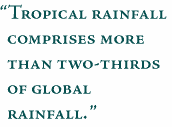

Tropical rainfall comprises more than two-thirds of global rainfall. It is the primary distributor of heat through the circulation of the atmosphere. Understanding rainfall and its variability is crucial to understanding and predicting global climate change. Our current knowledge of rainfall is poor, especially over the oceans. By use of a low-altitude orbit of 217 miles (350 kilometers), TRMM's complement of state-of-the-art instruments will provide more accurate measurements. These new measurements will increase our knowledge of how rainfall releases heat energy to drive atmospheric circulation. TRMM's orbit ranges between 35 degrees north and 35 degrees south of the equator, allowing TRMM to fly over each position on the Earth's surface at a different local time each day. Scientists can use data from this kind of orbit to calculate rain variations over a 24-hour period; the result will be a data set vastly more informative than any now available. TRMM is a joint project between the United States and Japan. The National Space Development Agency of Japan (NASDA) provided the Precipitation Radar (PR) and an H-II rocket that launched the TRMM observatory in November 1997 on a three year mission. NASA's Goddard Space Flight Center (GSFC) in Greenbelt, Md., provided the observatory, four instruments, integration and test of the observatory and will operate the TRMM satellite via the Tracking and Data Relay Satellite System (TDRSS). Science Objectives TRMM science objectives are:
|
by Steve Graham 
|